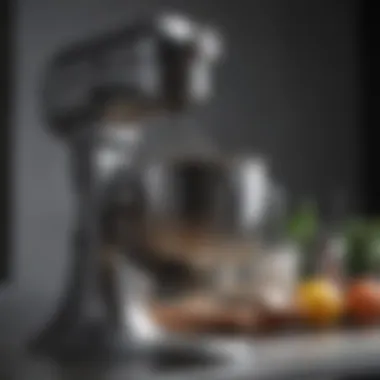The Ultimate Kitchen Mixer Machine Guide


Intro
The kitchen mixer machine represents a cornerstone in modern culinary practices. This article ensures you understand the significance of these machines in your cooking endeavors. Understanding kitchen mixers goes beyond their basic functions; it encapsulates their design, operational advantages, and maintenance aspects. This knowledge empowers you to enhance your culinary skills and efficiency in the kitchen.
In the current culinary landscape, where time-saving and precision are paramount, kitchen mixers take center stage. This guide provides a thorough exploration of various models, their unique features, and critical points to consider before making a purchase. It also delves into routine maintenance, ensuring your appliance serves you well over time.
Whether you're an experienced chef or a novice, this guide opens the door to smarter cooking. Each section fosters an understanding of how kitchen mixer machines simplify tasks, making them indispensable tools in culinary art. Knowing these machines allows you to navigate selection processes intelligently and operate them effectively.
Through these insights, readers will find the knowledge to choose the correct kitchen mixer and utilize it to its full potential.
Prelims to Kitchen Mixer Machines
Understanding kitchen mixer machines is paramount for anyone passionate about cooking or baking. These appliances have transformed food preparation, elevating both process and results. Whether you are a frequent host seeking efficiency during meal preparations or a culinary enthusiast aiming for professional-level outcomes, a kitchen mixer can be invaluable.
Kitchen mixer machines come in various forms, each serving distinct purposes. From stand mixers to hand mixers, their diverse functionalities cater to a wide range of culinary needs. This introduction underscores the evolution of these appliances, their growing popularity among households, and the advantages they bring to modern kitchens.
Investing in a kitchen mixer machine offers numerous benefits:
- Increased Efficiency: With a mixer, tasks that took hours can now be performed in minutes. Mixing, whisking, and kneading tasks become simpler, allowing home cooks to focus on creativity rather than labor.
- Superior Consistency: Hand mixing often leads to uneven textures in dough or batter. A kitchen mixer ensures uniform results, enhancing the quality of your baked goods and meals.
- Versatile Applications: Different attachments allow mixers to perform various tasks. From whipping cream to kneading bread dough, the possibilities are extensive.
When considering a kitchen mixer, it is essential to reflect on your specific needs. For instance, a passionate baker might favor a stand mixer for its power and versatility, while someone who bakes occasionally might consider a hand mixer as a more practical solution.
As we delve deeper into this guide, the intention is to equip homeowners, interior design enthusiasts, party hosts, and gardening aficionados with the knowledge necessary to choose and utilize kitchen mixer machines effectively. This foundational understanding is critical for any kitchen setup, thereby leading to greater culinary experiences.
"A kitchen mixer machine is not just an appliance; it is a tool that can enhance your food preparation experience and elevate your culinary creations to the next level."
By grasping the significance of these machines, readers will be able to make informed decisions that elevate their cooking or baking endeavors.
Types of Kitchen Mixer Machines
Understanding the types of kitchen mixer machines is crucial for making an informed decision when choosing one. Each type has unique characteristics, advantages, and suitable uses. Knowing these distinctions will help you leverage the mixer's strengths to enhance your culinary experiences. This section will detail stand mixers, hand mixers, commercial mixers, and mini mixers, highlighting their specific attributes.
Stand Mixers
Stand mixers are often seen as the cornerstone of home baking. They feature a fixed bowl that allows for hands-free mixing. This highlights their efficiency, especially when preparing larger batches of dough or batter. The robust construction typically includes a powerful motor that can handle thick mixtures with ease. Many stand mixers come with various attachments, such as dough hooks and whisking tools, making them versatile.
A significant advantage is their stability during operation. This allows you to multitask without worrying about holding the mixer. For creative home chefs, models like the KitchenAid Artisan or the Ankarsrum Original offer a multitude of colors and customizability, adding a flair to the kitchen.
Hand Mixers
Hand mixers provide a lightweight and portable option for kitchen mixing tasks. They are ideal for quick jobs, such as whipping cream or mixing small amounts of cake batter. Unlike stand mixers, they do not require a set space, which is beneficial for those with limited counter space.
The simplicity of a hand mixer is compelling. With just a few button presses, you can achieve good mixing results. Models from brands like Cuisinart or Hamilton Beach enable easy adjustments for speed, providing versatility for different culinary tasks.
Commercial Mixers
Commercial mixers are engineered for rigorous use in professional kitchens. They are built to withstand heavy usage and typically have features like larger capacity bowls and more powerful motors. This makes them suitable for extensive catering events or busy restaurants.
When investing in a commercial mixer, consider the specific equipment needs. Brands like Hobart are famous for their durability and consistent performance. Understanding the specifications can guide businesses in making the right choices for their operations.


Mini Mixers
Mini mixers serve as an alternative for those who require compact kitchen appliances. These mixers are less powerful than full-sized counterparts but can still fulfill basic mixing needs. Their small size makes them perfect for little kitchens or for individuals who do not bake in large quantities.
Despite their simplicity, mini mixers can efficiently handle tasks like mixing cookies or cake batters. Various options are available from brands like Black+Decker and Sunbeam, appealing to those looking for practical solutions in their culinary endeavors.
Selecting the right type of kitchen mixer can vastly improve your cooking and baking experiences.
By examining the specific features and functions of these different types, you can determine which best suits your lifestyle and cooking demands.
Key Features to Consider
When selecting a kitchen mixer machine, understanding the key features is crucial. These elements significantly influence performance, usability, and overall satisfaction with the appliance. Buyers should focus on several specific attributes to make an informed decision that aligns with their culinary needs.
Motor Power
Motor power is a defining feature of any kitchen mixer. It directly affects the mixer's efficiency and ability to handle tough tasks. A higher wattage often translates into more power, allowing the mixer to blend, whip, and knead with ease. For instance, a 300-watt motor may manage everyday tasks like whipping cream or mixing batter just fine. However, for more demanding recipes, like bread or cookie dough, a 600-watt motor or higher can prove beneficial. Homeowners should evaluate their cooking habits to decide on the appropriate motor power.
Capacity
Capacity is another essential consideration. Mixers come in various bowl sizes, impacting the volume of ingredients that can be processed at one time. A 4.5-quart bowl may suffice for small households, whereas larger families or those who frequently entertain may require a bowl up to 7 quarts. A larger capacity allows for efficient mixing of big batches, saving time in food preparation. Additionally, reviewing the mixer's dimensions is necessary to ensure it fits well in your kitchen space.
Speed Settings
Speed settings enhance versatility in a kitchen mixer. More speed options provide greater control over the mixing process. For instance, gentle speeds are preferable for folding delicate ingredients, while higher speeds work effectively for whipping egg whites or heavy creams. Many quality mixers feature 3 to 10 speed settings, allowing for customizability in mixing tasks. Buyers should look for a model that accommodates various culinary techniques, ensuring the mixer can adapt to a variety of recipes.
Attachments and Accessories
Attachments and accessories expand the functionality of kitchen mixers. Common additions include dough hooks, whisks, and mixing paddles. These tools enable the mixer to perform different tasks, such as kneading, whipping, or blending. Some brands go further by offering attachments like pasta makers or food processors, which increase the potential of your mixer. When purchasing a kitchen mixer, consider the availability of attachments and any specific needs based on your cooking preferences.
Ease of Cleaning
Ease of cleaning is often an overlooked feature yet vital for the longevity and efficiency of the mixer. Mixers with removable bowls and attachments simplify the cleaning process. Look for models with smooth surfaces since these can prevent accumulation of batter or moisture. Dishwashable parts are an added advantage, allowing effortless cleanup. A careful selection in this aspect can save time and maintain hygiene in the kitchen.
Conclusion: Understanding these key features will guide buyers in selecting a kitchen mixer that best fits their culinary lifestyle. Combining suitable motor power, capacity, varied speed settings, practical attachments, and easy cleaning processes contributes to a fulfilling cooking experience.
Benefits of Using Kitchen Mixer Machines
Kitchen mixer machines serve as indispensable tools in modern kitchens for various reasons. Their utility spans multiple facets of food preparation, promoting convenience and creativity for users at all skill levels. Understanding the benefits can help homeowners and culinary enthusiasts make informed decisions regarding their kitchen appliances.
Efficiency in Food Preparation
One of the primary advantages of using kitchen mixer machines is the notable efficiency they bring to food preparation. Whether it’s mixing dough for bread, whipping cream for desserts, or blending ingredients for sauces, these machines can save significant time and effort. Unlike manual mixing, which often requires the use of both hands and continuous attention, a mixer allows for hands-free operation. This means users can focus on other tasks while the machine does the work.
Moreover, the powerful motors found in stand and commercial mixers ensure that even the thickest batters and dough are mixed thoroughly. This efficiency translates directly into quicker meal preparation and less fatigue, especially during busy cooking sessions or when hosting events.
Versatility in Recipes
Kitchen mixer machines are not limited to a single task. Their versatility is one of their strongest selling points. With various attachments available, mixers can perform multiple functions. For instance, a stand mixer can be fitted with a dough hook for kneading, a whisk for aerating, or even a pasta maker. This type of adaptability makes them essential for diverse culinary tasks, from baking to preparing savory dishes.
Users can experiment with an array of recipes without needing a multitude of tools cluttering their kitchen space. This is particularly beneficial for homeowners who value both minimalist designs and functionality in their culinary environments.


Consistent Results
Another compelling benefit of kitchen mixer machines is their ability to deliver consistent results in food preparation. The precise mixing speeds and attachments help achieve uniformity that is often difficult to attain manually. For instance, when baking, the consistency of batter or dough can greatly affect the final outcome. A mixer can ensure a smooth blend, reducing the likelihood of lumps that could ruin a recipe.
In addition, the reliable results provided by these machines help in replicating recipes successfully. Homeowners can trust that their next batch of cookies or cake will turn out as desired, easing the stress of entertaining or family gatherings. This reliability builds confidence in culinary endeavors, encouraging even novice cooks to explore new recipes.
In summary, kitchen mixer machines boost efficiency, support a wide range of recipes, and ensure consistent outcomes, making them worthwhile investments for any kitchen.
Incorporating these appliances not only enhances the cooking experience but also empowers users to explore their culinary creativity without the usual constraints.
Operating a Kitchen Mixer Machine
Understanding how to operate a kitchen mixer machine is critical for achieving optimum results in your cooking and baking endeavors. The ability to effectively use these machines can greatly enhance your culinary output, providing consistent results, reducing manual effort, and allowing for a broader range of recipes. This section will cover necessary setup procedures, mixing techniques, and essential safety precautions.
Setup and Assembly
Setting up your kitchen mixer machine properly is the foundation of its effective use. Each model may have slight variations, but most share common steps:
- Unpack and Inspect: Remove the mixer from its packaging and check for any visible damage or missing parts. Familiarize yourself with the components, including the bowl, mixing attachments, and motor unit.
- Attach the Bowl: Secure the mixing bowl to the base of the mixer. Ensure it is locked in place as per the manufacturer’s instructions. This is crucial for stability during mixing.
- Select Attachments: Depending on your recipe, choose the appropriate mixing attachment—such as a whisk, dough hook, or paddle. Attach it securely to the motor head. Most attachments click into place, ensuring they do not come loose during operation.
- Plug In: Connect the mixer to a power outlet. Make sure the cord is clear from the mixing area to avoid any interference while operating.
By following these simple steps, you can ensure that the setup is straightforward and minimizes the risk of mistakes during mixing.
Mixing Techniques
Mixing techniques play a vital role in the overall success of your culinary efforts. Each technique serves a specific purpose:
- Creaming: This technique involves beating butter and sugar together until light and fluffy. It is essential for many baked goods, such as cookies and cakes.
- Folding: Used for incorporating delicate ingredients, like whipped cream or egg whites, without deflating them. A gentle motion is key.
- Kneading: With a dough hook, you can effectively knead dough for bread or pasta by allowing the mixer to work through gluten development. This process is usually faster and less labor-intensive than manual kneading.
- Whipping: For whipping cream or egg whites, use the whisk attachment. This technique aerates ingredients, creating a light and fluffy texture.
Each method takes advantage of the mixer’s motor power, ensuring consistent outcomes across your recipes.
Safety Precautions
Safety is crucial when operating a kitchen mixer. Neglecting safety can lead to accidents or equipment damage:
- Read the Manual: Familiarize yourself with the user guide that comes with your mixer. It contains important safety instructions tailored to your specific model.
- Do Not Overfill: Be cautious not to exceed the recommended bowl capacity. Overfilling can cause messes and may strain the motor.
- Unplug After Use: Always disconnect the mixer when not in use or when changing attachments. This minimizes the risk of accidental activation.
- Monitor While Mixing: Keep an eye on the mixer during operation to ensure it is functioning correctly. If there are unusual sounds or smells, turn it off immediately.
"Safety first! A simple mistake can lead to unnecessary injury or damage. Always prioritize safe practices while cooking."
Following these safety guidelines can ensure a seamless cooking experience while also prolonging the life of your kitchen mixer machine.
Common Issues and Troubleshooting
Understanding common issues related to kitchen mixer machines is crucial for effective usage. This knowledge can not only aid in resolving problems quickly but also prolong the lifespan of the mixer. By identifying issues early, users can minimize downtime and maintain efficiency. This section focuses on the common problems you might face while operating your kitchen mixer and offers practical solutions to handle them.
Mixer Not Turning On
One of the most frustrating problems a user can encounter is the mixer not turning on at all. If your mixer remains silent when you expect it to work, there are several aspects to investigate. First, check the plug and power outlet. There could be a loose connection or faulty outlet. Plug the mixer into a different outlet to determine if the original outlet is the issue.
Next, inspect the fuse or circuit breaker. If the breaker has tripped or the fuse has blown, reset the breaker or replace the fuse. Additionally, some mixers have safety switches that prevent operation if the bowl or attachment is not properly engaged. Ensure all components are correctly in place. If the problem persists, it might be time to consult the user manual or seek professional help for electrical issues.


Overheating Problems
Overheating is another common problem that can occur with kitchen mixers, particularly during intensive mixing tasks. If your machine becomes excessively hot, it’s important to allow it to cool down before proceeding. Continuous use without breaks can strain the motor, leading to overheating. Most manufacturers provide recommendations for maximum operation times, which should be followed closely.
If your mixer continues to overheat, there could be internal malfunctions, such as worn bearings or a malfunctioning motor. Regular maintenance can help prevent such issues. Ensure you are cleaning the mixer parts regularly and checking for any buildup that could obstruct motor function.
Inconsistent Mixing
Inconsistent mixing can lead to poor baking results, causing frustration for any cook or baker. This issue often arises from incorrect attachments being used or improper speed settings. Ensure that the correct beater, such as the dough hook or whisk, is used for the task at hand. Using the wrong attachment can lead to less than optimal mixing performance.
Another factor to look at is the ingredient temperature. Cold ingredients can cause clumping or uneven mixing. Allow ingredients to reach room temperature before using the mixer. Adding ingredients gradually rather than all at once can also promote better mixing.
Finally, check the mixer itself for any mechanical issues. Worn gears or improper functioning of the motor can also result in inconsistent mixing. Regular inspections and adhering to manufacturer guidelines will help identify problems early, ensuring your mixer operates smoothly.
Regular maintenance and troubleshooting knowledge are essential for keeping your kitchen mixer in top condition.
By understanding these common issues and knowing how to troubleshoot them, users can maintain their kitchen mixers effectively. This ensures a seamless cooking process, ultimately enhancing overall culinary experiences.
Maintenance Tips for Longevity
Maintaining your kitchen mixer machine is crucial for ensuring its durability and performance. Regular upkeep not only extends the life of your appliance but also enhances its safety and efficiency during operation. Neglecting proper maintenance can lead to issues such as inconsistent mixing, overheating, or even complete equipment failure. By adopting a systematic approach to maintenance, you can enjoy optimal performance from your kitchen mixer for many years.
Regular Cleaning Routine
A cleaning routine is essential for any kitchen mixer machine. Food particles can get trapped in various components if not cleaned properly, leading to bacterial growth and potential health risks. Establish a routine that includes washing the bowl and attachments after each use to prevent contamination. For the exterior, a simple wipe-down with a damp cloth is usually sufficient. Avoid using abrasive cleaning products that may scratch the surface or damage the finish.
It's recommended to disassemble the mixer for thorough cleaning at least once a month. Immerse the removable parts such as the bowl and whisk in warm, soapy water. This will help to remove grease and food residue efficiently. For the main unit, use a damp cloth to clean the interior and check for leaks around the seals.
Inspection of Parts
Regular inspection of your kitchen mixer's components is critical. This will help identify any wear or damage that could affect functionality. Key parts to check include the bowl, beaters, and motor. Look for signs of wear such as cracks in the bowl or bent beaters, which could impede their performance. The motor should also be monitored for any unusual sounds or overheating during use.
Replacing worn-out parts promptly can prevent further damage and ensure optimal operation. If your mixer makes strange sounds, it may be time to inspect the gears or motor. Refer to the user manual for guidance on the proper way to conduct these checks and the recommended intervals for inspections.
Storing Your Mixer
Proper storage is essential to maintain your kitchen mixer machine’s longevity. If you use your mixer frequently, you may keep it on the countertop. However, if it is less frequently used, consider storing it in a cabinet or pantry to protect it from dust and debris.
When storing, ensure the mixer is completely clean and dry. Remove attachments and store them separately to avoid scratching the mixer’s surface. If the mixer has a cover, use it to shield from dust and other contaminants.
"Proper maintenance ensures your kitchen mixer remains a reliable companion in your culinary endeavors."
By following these maintenance tips, you will not only prolong the life of your kitchen mixer but also uphold its performance. An investment in maintenance is an investment in the quality of your kitchen experiences.
End
The conclusion of this article serves as an essential final reflection on the significance of kitchen mixer machines in culinary practices. These appliances are not merely tools; they are integral to enhancing efficiency and precision in food preparation.
One of the key elements to emphasize is the versatility that kitchen mixers offer. They cater to an array of cooking and baking tasks, whether you are whipping cream, kneading dough, or mixing batter. This adaptability allows both novices and seasoned chefs to explore different culinary techniques without the tedium associated with manual mixing.
Moreover, a properly chosen kitchen mixer can significantly impact the quality of your food. Consistent mixing not only ensures even distribution of ingredients but also contributes to improved texture and flavor in dishes. This reliability is particularly important in baking, where precision can mean the difference between a perfect soufflé and a flat cake.
When considering the purchase of a kitchen mixer machine, it is crucial to take into account factors such as motor power, capacity, and the variety of attachments available. These considerations will directly influence your overall cooking experience and satisfaction with the machine.
"Investing in a quality kitchen mixer is investing in your culinary creativity."
In summary, the conclusion rectifies the core value of comprehending the specifications and functionalities of kitchen mixers. This knowledge not only aids in making informed decisions but also prepares users for optimal operation and diligent maintenance, ensuring longevity and continuous performance. The journey towards mastering kitchen techniques is empowered by these versatile machines, making them indispensable for any culinary enthusiast.



